Last week’s “What Is It!” apparently stumped A Glimpse of Nature’s readers. Such peculiar objects – bright-orange, gelatinous balls hanging from a conifer! Those in the photo were about 2 inches in diameter.
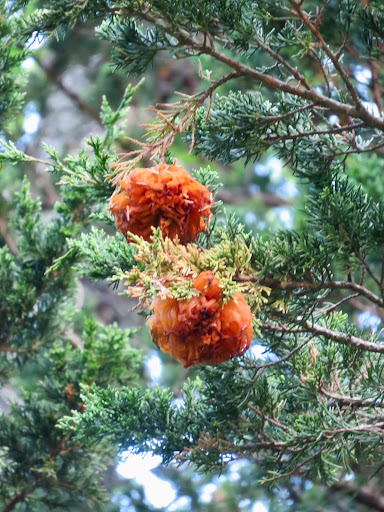 Pembroke, May 21, 2023 Even from a distance, these gooey globs stand out. The image below depicts two large “ornaments” and at least five smaller ones.
Pembroke, May 21, 2023 Even from a distance, these gooey globs stand out. The image below depicts two large “ornaments” and at least five smaller ones.  Pembroke, May 21, 2023
Pembroke, May 21, 2023
Anyone familiar with North American conifers knows they don’t produce orange fruit. This tree, an eastern red cedar, makes blue berry-like cones. So, what’s going on?
Meet cedar-apple rust, a fungal disease that infects two of our most common plants. Like other rusts, this parasitic fungus feeds off of live plant tissue. “The rusts have evolved specialized structures that allow them to penetrate and obtain nutrients from living host cells,” according to the USDA’s fact sheet, The Rust Fungi. Cedar-apple rust utilizes each host at a particular stage of its life cycle, something savvy naturalists can observe throughout the year.
During autumn and winter, a walker might see reddish-brown galls (tumor-like growths) attached to the branches of a red cedar. Look closer, and you will notice dimples covering the gall’s surface.
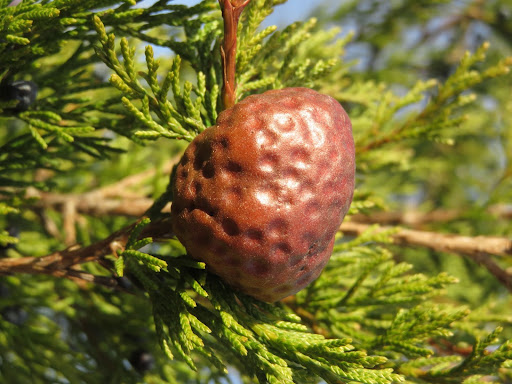 Cedar-Apple Rust, Overwintering Gall, Hanson, November 11, 2021
Cedar-Apple Rust, Overwintering Gall, Hanson, November 11, 2021
The galls change dramatically in spring when orange “horns” emerge from those dimples! UMass Extension describes the transformation thus: “During prolonged wet periods in the spring, typically from late April to late May in southern New England, the juniper galls secrete orange-brown gelatinous tendrils (known as telial “horns”).” They are hard to miss if you are in the right place at the right time, but that conspicuous stage is brief.
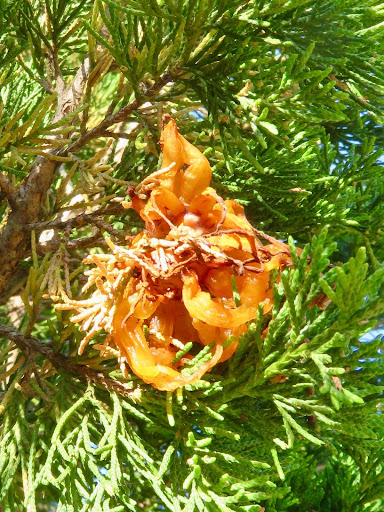
Cedar Apple Rust, Pembroke, June 10, 2023
These tendrils produce spores. Rusts, like all other fungi, reproduce through spores rather than seeds. In the case of rusts, however, the process can be more complex than “ordinary” mushrooms. Some rusts produce five kinds of spores from unique fruiting bodies; cedar-apple rust makes four.
Between rains, the telial horns shrivel into threads, but they may produce additional spores after more rain.
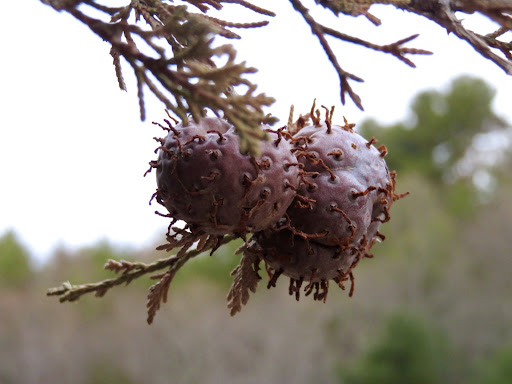
Cedar Apple Rust, April 25, 2020
Soon afterward, the tiny spores travel by wind to infect the wet leaves of apple and crabapple trees. Note that water is necessary for their germination. By summer, one can see rust spots on apple leaves.
 Pembroke, June 29, 2023 The rust organism will develop on the apple tree until – you guessed it – it produces spores that will travel back to the red cedar. The entire cycle is summarized in this Wikipedia article and the simplified chart below.
Pembroke, June 29, 2023 The rust organism will develop on the apple tree until – you guessed it – it produces spores that will travel back to the red cedar. The entire cycle is summarized in this Wikipedia article and the simplified chart below. 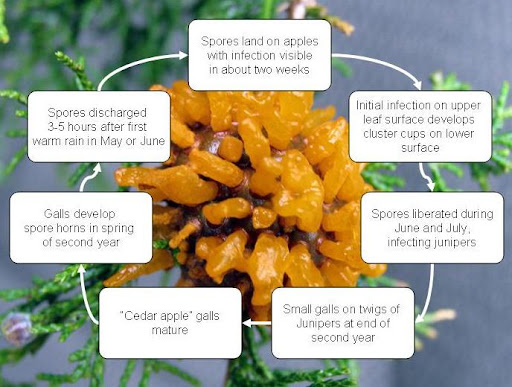
Littleinfo, Public domain, via Wikimedia Commons
Like other rusts, this species is specific to its hosts (junipers and apples/crabapples) and cannot infect other plant families. Other rusts exist for that purpose: approximately 7000 of them according to the USDA. The Royal Horticultural Society tells us that rusts affect “many different garden plants” including “trees, shrubs, herbaceous and bedding plants, grasses, bulbs, fruit and vegetables.” That about covers it, I should think. Here are a few examples from my observations and those of our readers. 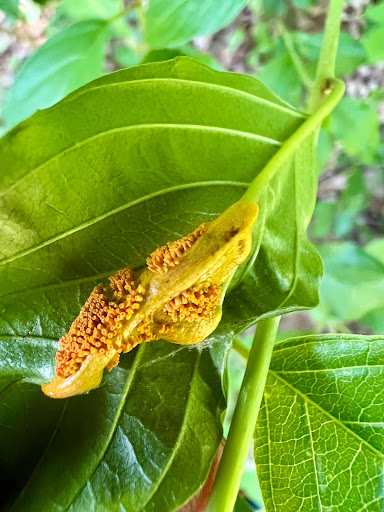
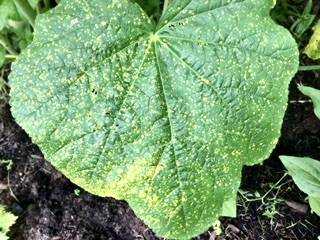 Crown Rust, Easton, May 30, 2023 Courtesy: Lori P. Hollyhock Rust, June 27, 2023 Courtesy: Nancy A.
Crown Rust, Easton, May 30, 2023 Courtesy: Lori P. Hollyhock Rust, June 27, 2023 Courtesy: Nancy A. 
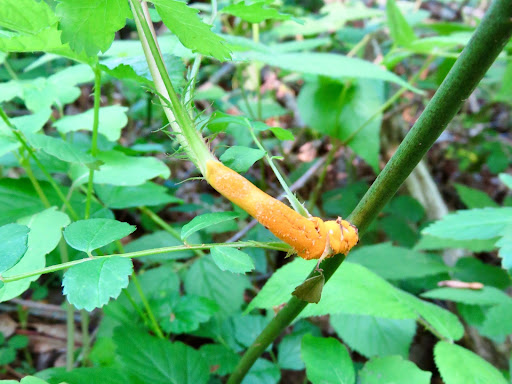 Blackberry Orange Rust, Hanover, June 4, 2023 Multiflora Rose Rust, Pembroke, May 21, 2023 It’s easy to see how the rust fungi got their name. The spore-bearing pustules are often some shade of orange, yellow, or brown; that is, “rust” colored. These parasitic fungi can lessen the host’s vigor, cause disfigurement, and reduce productivity. Most do not kill their hosts which, after all, would be self-defeating. Nevertheless, rusts cause severe problems for crops such as oats, wheat, soybeans, and white pine.
Blackberry Orange Rust, Hanover, June 4, 2023 Multiflora Rose Rust, Pembroke, May 21, 2023 It’s easy to see how the rust fungi got their name. The spore-bearing pustules are often some shade of orange, yellow, or brown; that is, “rust” colored. These parasitic fungi can lessen the host’s vigor, cause disfigurement, and reduce productivity. Most do not kill their hosts which, after all, would be self-defeating. Nevertheless, rusts cause severe problems for crops such as oats, wheat, soybeans, and white pine.
If you should find rust on your roses (or pansies, or florist’s geraniums, or fuchsias, or chrysanthemums, etc.), try to keep the plant’s foliage dry by watering at ground level and providing ample air circulation. Remove and burn or bury infected leaves. Rust diseases on food crops are more challenging to manage. The wise gardener (!) would select rust-resistant cultivars and be alert to nearby rust hosts. The less-than-wise gardener might take some pleasure in this fascinating set of organisms and their evolutionary dance with plants.